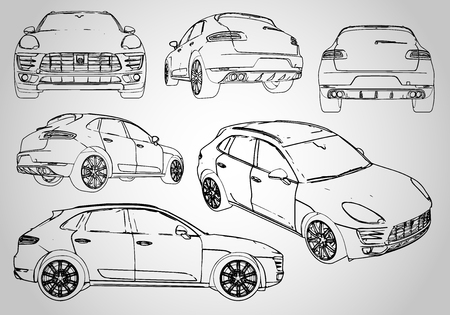Overview of Vehicle Imports in Post-Brexit Britain
The United Kingdom’s departure from the European Union marked a new chapter in the nation’s economic and cultural narrative—a shift that has been keenly felt in the world of vehicle imports. Once defined by seamless trade within the single market, Britain now stands at the crossroads of tradition and transformation, recalibrating its approach to bringing vehicles from across the Channel and beyond. The process, once straightforward for both private buyers and seasoned dealers, has grown more intricate, underscored by new customs checks, import tariffs, and regulatory nuances unique to post-Brexit Britain. This evolving landscape has not only reshaped the practicalities of registration and taxation but also influenced consumer expectations and dealer strategies. As we delve into this complex terrain, it becomes clear that understanding the ripple effects of Brexit on imported vehicles is essential for navigating today’s British automotive market—where every purchase tells a story shaped by history, policy, and the enduring spirit of British motoring culture.
2. Navigating the Registration Process
Registering an imported vehicle in the UK has always required a careful approach, but Brexit has introduced new complexities and documentation demands. Below is a step-by-step guide to navigating the current DVLA registration process, with key distinctions highlighted between pre- and post-Brexit procedures.
Step-by-Step Guide: Import Vehicle Registration Post-Brexit
- Obtain Import Documentation: All vehicles now require a Certificate of Conformity (CoC) or individual approval. For non-EU imports, an Individual Vehicle Approval (IVA) may be mandatory.
- Customs Clearance: Submit a customs declaration and pay any relevant duties and VAT before the vehicle can enter the UK registration system.
- Vehicle Identity Check: Arrange for an inspection if required by the DVLA, particularly for used or non-standard vehicles.
- Insurance Cover: Secure valid UK insurance prior to registration.
- MOT Testing: Vehicles over three years old need to pass a UK MOT test, ensuring roadworthiness and compliance with British standards.
- DVLA Application: Complete form V55/4 (for new vehicles) or V55/5 (for used vehicles), providing all supporting documents as detailed below.
- Pay Registration Fees: Settle the first vehicle tax payment and registration fee before your vehicle is officially registered and assigned its number plates.
Key Differences: Pre- vs Post-Brexit
| Pre-Brexit | Post-Brexit | |
|---|---|---|
| Documentation Needed | Simplified for EU imports; often accepted EU paperwork directly | Full customs paperwork, proof of VAT payment, stricter CoC or IVA requirements even for EU vehicles |
| Duties & VAT | No import duty or additional VAT for EU vehicles | Duties and VAT now apply to all non-UK vehicles, including those from the EU |
| MOT & Inspections | MOT required; less frequent inspections for EU vehicles meeting harmonised standards | MOT plus possible extra inspections for compliance, especially for unique specifications or left-hand drive models |
| Processing Time | Generally quicker for EU imports due to mutual recognition agreements | Takes longer due to increased scrutiny and documentation checks at every stage |
| Registration Fees | No difference based on origin within the EU | No change in fee structure, but additional costs accrue from customs processes and compliance testing |
Navigational Tips for Newcomers and Seasoned Importers Alike
If you are importing a car to Britain today, meticulous record-keeping and early preparation are more crucial than ever. The DVLA expects comprehensive documentation at every turn — from proof of origin to evidence of tax payments. While these changes echo broader shifts in the UK’s relationship with Europe, they underscore the value of patience and precision for anyone eager to experience British motoring heritage with their imported vehicle.

3. Understanding Duties, VAT, and Customs Checks
With the United Kingdom charting its course post-Brexit, the seemingly simple act of importing a vehicle has transformed into a complex ballet of tariffs, taxes, and procedural rigour. For many years, seamless movement within the EU meant importing vehicles was relatively straightforward—customs checks were largely symbolic, duties minimal, and VAT considerations predictable. Now, however, each imported vehicle faces a new landscape shaped by the UKs sovereign trade policies.
Unpacking Tariffs: The New Financial Frontier
The introduction of import duties is perhaps the most tangible change for individuals and businesses bringing vehicles into Britain. Previously exempt under EU free movement rules, cars imported from the continent may now attract tariffs of up to 10% on their value if they do not meet specific rules of origin requirements. This cost is immediate and non-negotiable, significantly impacting the overall price tag of your desired motor.
VAT: A Costly Consideration
Value Added Tax (VAT) is another pillar in the new structure. Imported vehicles are subject to 20% VAT on top of any applicable duty—calculated not just on the purchase price, but also including shipping and insurance costs. Even for second-hand vehicles, VAT can become a considerable burden unless you qualify for certain exemptions or reliefs such as Transfer of Residence.
Customs Checks: Complexity at the Border
Gone are the days when a car could glide through Dover with little more than a nod from customs officials. Today’s process involves comprehensive paperwork—customs declarations, proof of compliance with UK safety standards, and evidence of origin. Any misstep or missing document can result in delays, additional charges, or even outright refusal at the border. These rigorous checks add layers of complexity and unpredictability to an already costly process.
In sum, the post-Brexit landscape demands both financial prudence and administrative diligence from anyone wishing to bring a vehicle into the UK. The old ease has been replaced by a system that prizes documentation and compliance as much as it does payment—making it ever more vital to plan ahead and understand every facet of these new regulations.
4. Compliance with British Standards
In the wake of Brexit, the process for ensuring imported vehicles are compliant with British standards has become more rigorous, reflecting the UK’s commitment to road safety and environmental protection. Every vehicle entering from abroad must now meet stringent requirements before it can lawfully grace British roads. The core pillars of compliance revolve around the MOT (Ministry of Transport) test, emissions regulations, and lighting standards—all designed to ensure that imported cars are both roadworthy and attuned to the unique demands of British motoring.
MOT: The Roadworthiness Test
The MOT is not merely a formality; it is a rite of passage for every vehicle wishing to join Britain’s storied highways. Imported vehicles must undergo a thorough inspection, assessing everything from brakes and tyres to steering and suspension. Without this certificate, registration is impossible—a testament to the nation’s unwavering focus on safety.
Emissions: Cleaner Air for a Greener Britain
Brexit has allowed the UK to set its own emissions benchmarks, often aligning with or exceeding previous EU standards. Importers must ensure their vehicles comply with these strict limits, which are enforced through both MOT emissions checks and specific rules for low emission zones in cities like London. Non-compliance can result in steep fines or outright rejection at the point of registration.
Lighting Standards: Seeing and Being Seen
British roads demand unique adaptations when it comes to vehicle lighting—especially headlamp alignment for driving on the left. Imported vehicles may require modifications such as beam converters or new light units to meet UK specifications. Rear fog lights and indicators also need to conform to local regulations to guarantee maximum visibility and safety in all conditions.
Summary Table: Key Compliance Requirements
| Compliance Area | Requirement | Notes |
|---|---|---|
| MOT Test | Annual roadworthiness check | Required before registration |
| Emissions | Must meet UK-specific standards | Check local zone requirements |
| Lighting | Headlamps, rear fog, indicators | May require modification |
Navigating Post-Brexit Complexity
The increased complexity following Brexit reflects Britain’s drive for higher standards and its distinct automotive identity. For those importing vehicles, understanding and meeting these requirements is no longer just a bureaucratic step—it is an essential journey towards becoming part of Britain’s proud motoring tradition.
5. The Road Tax Conundrum
For decades, the UK’s vehicle excise duty (VED)—better known as road tax—has been an inescapable aspect of motoring life. However, Brexit has introduced a new layer of complexity for owners of imported vehicles. Traditionally, VED rates were determined by factors such as emissions and vehicle value, but the calculation for imported cars has evolved since leaving the EU. Now, customs duties and VAT imposed at the border are added to the cost basis, which can push certain models into higher tax brackets. This subtle change means that what was once a straightforward budgeting exercise for car owners has become a veritable conundrum.
The New Calculation Paradigm
Under post-Brexit regulations, imported vehicles must undergo a reassessment for VED purposes. Previously, many EU-sourced models benefited from harmonised standards and sometimes lower taxes. Today, these imports might attract additional tariffs or lose eligibility for exemptions, depending on their origin and specifications. The knock-on effect is that even eco-friendly models may carry a heavier fiscal burden than their British-registered counterparts.
Impact on Owners’ Budgets
For motorists considering an imported gem—from classic Italian sports cars to innovative German hybrids—this shift translates directly into higher annual costs. Many find themselves recalculating not only purchase prices but also long-term running expenses. Budget-conscious drivers now need to scrutinise VED bands more closely, as the interplay between customs charges and emissions ratings can make or break the affordability of owning an imported vehicle in post-Brexit Britain.
Navigating the Maze
The landscape is undeniably more labyrinthine, with guidance from HMRC and the DVLA often required to decipher specific cases. Savvy importers consult experts or use online calculators tailored to post-Brexit rules to avoid unpleasant surprises. Ultimately, while Britain’s roads remain open to international motoring culture, owners must now approach the road tax question with the analytical eye of a seasoned accountant—ensuring every figure is checked before setting off on their next journey.
6. Impact on the UK Motor Trade and Drivers
The reverberations of Brexit have woven themselves into the very fabric of the UK motor trade, reshaping both business practice and consumer experience in profound ways. For dealers and importers, the new customs landscape has introduced a labyrinth of documentation and compliance requirements, transforming what was once a seamless process into a complex operation reminiscent of a bygone era when borders mattered more than markets. This has not only slowed the supply chain but also increased administrative costs—a burden inevitably passed on to motorists.
Availability: A Shifting Marketplace
The immediate effect for British car enthusiasts is most palpable in vehicle availability. With additional checks at ports and a new layer of bureaucracy, delivery times for imported vehicles have lengthened. The choice of models—particularly continental favourites—has narrowed, as some manufacturers reconsider their UK allocations amidst regulatory uncertainty. For specialist or niche vehicles, waiting lists have become longer, testing the patience of even the most ardent collectors.
Pricing Pressures and Economic Realities
Pricing dynamics have also shifted since Brexit. Import tariffs, VAT adjustments, and fluctuating exchange rates all conspire to drive up costs. Dealers must now factor in these variables when setting prices, making imported vehicles less competitive against domestic alternatives. For drivers, this translates into higher purchase prices and potentially steeper running costs due to changes in road tax bands for certain imports—particularly those with higher emissions or non-standard specifications.
A Glimpse into the Long-Term Outlook
Looking ahead, the British motor market finds itself at a crossroads. While some predict that new trade agreements could eventually smooth the path for imports, others foresee a gradual shift towards home-grown models as manufacturers adapt to local demand and regulatory frameworks. Dealers may seek innovative solutions—such as forming pan-European partnerships or focusing on electric vehicles that meet evolving standards—to maintain their competitive edge.
For UK motorists, these changes herald an era where the provenance of one’s vehicle is not just a matter of taste but of practicality and economics. As tradition meets transformation, those navigating the post-Brexit motoring landscape must remain agile—embracing both heritage and innovation as they steer through uncharted territory.


